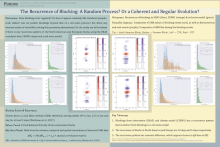The Recurrence of Blocking and Extreme Events: A Random Process? Or a Coherent and Regular Evolution?
Ka Ying
Ho
Purdue University
Poster
While synoptic weather systems typically last 3-5 days, atmospheric blocking, the stagnation of the weather systems, can last for 7-10 days, causing surface extreme weather events. While the duration, intensity, geographic distribution, and size of blocking have been well studied, the recurrence nature of atmospheric blocking, i.e. whether blocking has a characteristic return period, remains unclear, and is of great interest from the predictability’s perspective. The questions of whether blocking is distinct from transient synoptic eddies, which are often represented by a red noise model, and whether the predictability of blocking can go beyond that of a red noise process, have not been answered. Recent progress on a new mode of internal variability with a 20-30 day periodic behavior has shed lights on the possible recurrence of blocking events, which can also potentially improve the predictability of atmospheric blocking and extreme events on subseasonal-to-seasonal timescales.
In this work, we will evaluate the recurrence of blocking events and extreme precipitation as well as their correlations. We will adopt a local wave activity framework modified from Martineau et al. (2017) to capture blocking events and their return periods from the ERA5 reanalysis data and CESM LENS model output. From the list of events, we obtain a statistic of the return periods of events at certain locations, and evaluate the validity of their recurrence and correlations. The recurrence of blocking from data will be compared to that from a 2D red noise model, as described in Masato et al. (2008), to conclude the predictability of blocking from the underlying statistics.
In this work, we will evaluate the recurrence of blocking events and extreme precipitation as well as their correlations. We will adopt a local wave activity framework modified from Martineau et al. (2017) to capture blocking events and their return periods from the ERA5 reanalysis data and CESM LENS model output. From the list of events, we obtain a statistic of the return periods of events at certain locations, and evaluate the validity of their recurrence and correlations. The recurrence of blocking from data will be compared to that from a 2D red noise model, as described in Masato et al. (2008), to conclude the predictability of blocking from the underlying statistics.

Poster file
Ka Ying_Ho_Blocking_Poster.pdf
(6.76 MB)
Meeting homepage
